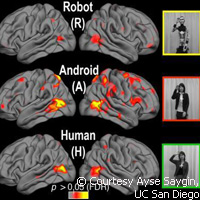Scientists investigate human reaction to androids
Are people wary of or even repulsed by androids? Scientists believe they are; while human replicas look and act a lot like human beings, people will have feelings of disgust for them at some point. The Japanese robotics researcher, Masahiro Mori, coined the term 'uncanny valley' in the 1970s to describe this phenomenon. The 'valley' is a dip in a proposed graph of the android's likeability when it loses its machine-like characteristics and becomes too human-like. An international research team investigated the uncanny valley phenomenon by probing the brains of people watching videos of an uncanny android called Repliee Q2. The findings, published in the journal Social Cognitive and Affective Neuroscience, suggest that a perceptual mismatch between appearance and motion is responsible for these feelings. Led by the University of California (UC) San Diego in the United States, researchers say humans have positive reactions to an agent (android) that has some human-like characteristics. Cartoon characters, dolls and even Star Wars' R2D2 were and continue to be popular with many. And while most people like the agents that become more human-like, the upward trajectory stops at some point, generating the feeling that the agent is both strange and upsetting. Lead author of the study from UC San Diego Ayse Pinar Saygin and her colleagues evaluated what they call the 'action perception system' in the human brain. Is this system tuned more to human appearance or to human motion? The target was to pinpoint the functional properties of brain systems that enable people to understand the actions and movements of others. The experiment was carried out using a 20-strong sample of people between the ages of 20 and 36 who were considered newbies to the study of robotics. They had no experience in working with robots nor had they spent time in Japan; people living in the Asian state are more inclined, culturally, to accept androids and interact with them. A total of 12 videos of Repliee Q2 were shown to the 20 study participants. Repliee Q2 performed a number of actions like picking up a piece of paper, drinking water and waving. The subjects also observed videos of the same actions performed by the human on whom the agent was modelled, as well as by a stripped version of the android - metal joints and wiring showing. Three conditions were established: a human with biological appearance and movement, a human-like agent with the mechanical movement of the robot, and a robot with both mechanical motion and appearance. All participants were initially shown all videos outside the functional magnetic resonance imaging (fMRI) scanner; they were informed which was human and which was a robot. The researchers observed the most significant difference in brain response during the android condition. This was in the parietal cortex, on both sides of the brain, in the areas that connect the part of the brain's visual cortex that processes bodily movements with the area of the motor cortex that scientists believe contains mirror neurons (empathy neurons). Based on the fMRI results, the team believes a mismatch was the outcome. The brain 'lit up' when the human-like appearance of the android and its robotic motion 'didn't compute'. 'The brain doesn't seem tuned to care about either biological appearance or biological motion per se,' Professor Saygin says. 'What it seems to be doing is looking for its expectations to be met - for appearance and motion to be congruent.' Basically, people are fine with the agent looking human and moving like a human. And we're also OK with it if it looks and acts like a robot. The problem starts when looks and motion are at odds. 'As human-like artificial agents become more commonplace, perhaps our perceptual systems will be re-tuned to accommodate these new social partners,' the authors write in the paper. 'Or perhaps, we will decide it is not a good idea to make them so closely in our image after all.' Researchers from Denmark, France, Japan and the United Kingdom contributed to this study.For more information, please visit: Social Cognitive and Affective Neuroscience: http://scan.oxfordjournals.org/ UC San Diego: http://www.ucsd.edu/
Countries
Denmark, France, Japan, United Kingdom, United States



